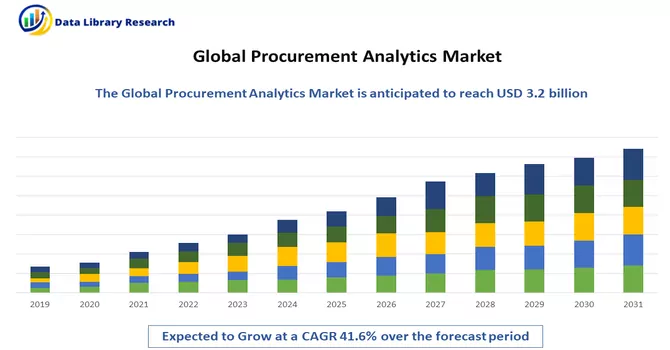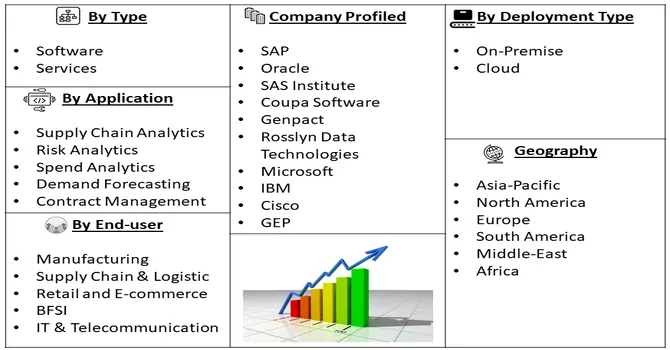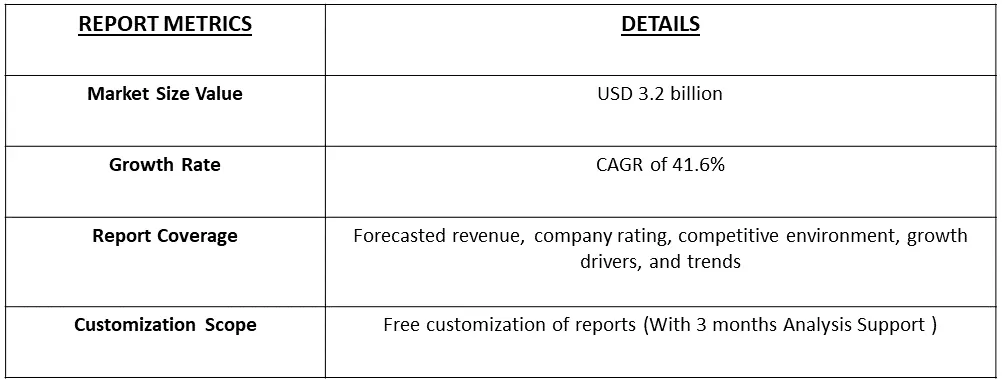The global procurement analytics system market size was valued at USD 3.2 billion in 2023 and is expected to expand at a compound annual growth rate (CAGR) of 41.6% from 2024 to 2031.

Get Complete Analysis Of The Report - Download Free Sample PDF
Procurement analytics refers to the systematic use of data analysis and business intelligence tools to gain insights into an organization's procurement activities. It involves collecting, processing, and analyzing procurement-related data to enhance decision-making processes, optimize efficiency, and improve overall performance within the procurement function. Procurement analytics leverages various metrics, key performance indicators (KPIs), and statistical methods to evaluate and interpret data from the procurement lifecycle. By analyzing potential risks in the supply chain, such as disruptions, geopolitical factors, or supplier financial instability, to develop strategies for mitigating risks and ensuring business continuity.
The sector is capitalizing on the growing need for operational efficiency, aligning with the broader trend of businesses prioritizing streamlined operations. A pivotal transformation is underway, driven by the integration of robust data analytics across various facets of procurement, encompassing negotiations, performance management, vendor segmentation, and annual purchasing planning. Within the procurement domain, a vast reservoir of data exists, comprising transaction histories, expenditure details, and various pertinent information. By harnessing the capabilities of intelligent analytics, organizations can extract valuable insights from this wealth of data, paving the way for enhanced decision-making processes and more informed business strategies. The strategic application of analytics not only optimizes current practices but also positions businesses to navigate evolving market dynamics with agility and foresight.
The Procurement Analytics market is witnessing several trends that are shaping the landscape of procurement strategies and operations. Organizations are increasingly adopting advanced analytics techniques such as predictive analytics, prescriptive analytics, and machine learning to gain deeper insights into procurement data. This enables better forecasting, risk management, and decision-making. Furthermore, the integration of AI technologies in procurement analytics is becoming more prevalent. AI-driven solutions help automate routine tasks, enhance data accuracy, and provide intelligent recommendations for optimizing procurement processes. The trend towards mobile accessibility in procurement analytics is gaining traction. Mobile applications enable procurement professionals to access critical data and analytics on the go, facilitating faster decision-making and responsiveness.
Market Segmentation: The Procurement Analytics Market is segmented by type (Software, Services), deployment type (On-Premise, and Cloud), Application (Supply Chain Analytics, Risk Analytics, Spend Analytics, Demand Forecasting, and Contract Management), end-user (Manufacturing, Supply Chain & Logistic, Retail, and E-commerce, BFSI, IT & Telecommunication), and geography (North America, Europe, Asia Pacific, Rest of the World ). The market sizes and forecasts are provided in terms of value (USD) for all the above segments.

For Detailed Market Segmentation - Download Free Sample PDF
Market Drivers:
Rising Adoption in Procurement Process in Industries
The Procurement Analytics market is experiencing a surge in adoption across various industries as organizations recognize the transformative potential of analytics in streamlining their procurement processes. Industries ranging from manufacturing to healthcare are increasingly integrating procurement analytics solutions to enhance their operational efficiency, cost-effectiveness, and decision-making capabilities. One key driver behind the rising adoption is the need for businesses to gain deeper insights into their procurement activities. Procurement analytics enables organizations to analyze vast amounts of data related to supplier performance, purchase history, and market trends. By leveraging advanced analytics tools, businesses can identify cost-saving opportunities, optimize supplier relationships, and make more informed decisions throughout the procurement lifecycle. In the healthcare sector, where procurement is critical for ensuring the availability of medical supplies and equipment, analytics plays a pivotal role in demand forecasting, inventory management, and cost optimization. Healthcare providers are increasingly turning to procurement analytics to make data-driven decisions that positively impact patient care and overall operational efficiency. Thus, the procurement analytics market is witnessing increased traction as industries recognize the strategic value of data-driven procurement processes. The adoption trend is expected to continue, driven by the ongoing digital transformation efforts and the desire for enhanced efficiency and cost-effectiveness across diverse sectors.
Rising Demand for Cloud-Based Analytical Solutions
The procurement analytics landscape is witnessing a significant uptick in demand, fueled in part by the rising popularity of cloud-based analytical solutions. As organizations across various industries recognize the advantages of cloud technology, the procurement analytics market is experiencing a transformative shift towards cloud-based solutions. One of the key drivers behind the growing demand for cloud-based procurement analytics is the flexibility and scalability offered by cloud platforms. Cloud solutions enable organizations to access, analyze, and manage vast amounts of procurement data from anywhere, providing real-time insights and fostering agility in decision-making. This flexibility is particularly crucial for businesses with distributed teams or global supply chains, allowing seamless collaboration and accessibility. Furthermore, the recent developments are expected to drive the growth of the studied market over the forecast period. For instance, in August 2022, the SAS Institute Inc. and SingleStore forged a strategic alliance aimed at eliminating obstacles to data accessibility, optimizing performance and scalability, and unlocking crucial data-driven insights for organizations. Through this collaboration, SAS Viya seamlessly integrates with SingleStore's cloud-native real-time database, enabling the application of SAS analytics and AI technology to data stored in SingleStore. This integration delivers adaptable and open access to curated data, expediting value realization across various deployment environments, including cloud, hybrid, and on-premises setups. Thus, due to the above-mentioned factors the market is expected to witness significant growth over the forecast period. Market Restraints: Lack of Trained and Skilled Analytical Professionals and Growing Data Breaches Cases The growth trajectory of the procurement analytics market faces potential impediments due to two critical challenges: the scarcity of trained and skilled analytical professionals and the escalating instances of data breaches. Firstly, the shortage of adequately trained and skilled analytical professionals poses a significant hurdle to the widespread adoption and effective utilization of procurement analytics solutions. The complexity of analytics tools and the intricate nature of procurement data analysis demands a workforce equipped with specialized skills. The industry is grappling with a shortage of professionals capable of harnessing the full potential of these advanced analytical tools, hindering organizations from fully leveraging procurement analytics for informed decision-making. Secondly, the growing prevalence of data breaches is a pressing concern that may impede the growth of the procurement analytics market. As organizations increasingly rely on digital platforms to manage and analyze their procurement data, the risk of cyber threats and data breaches escalates. The compromise of sensitive procurement information not only jeopardizes the integrity and confidentiality of data but also erodes trust in analytics solutions. This heightened vulnerability to data breaches poses a challenge to the seamless adoption and integration of procurement analytics tools. Thus, such factors are expected to slow down the growth of the studied market over the forecast period.
The COVID-19 pandemic has had a notable impact on the procurement analytics market, influencing various aspects of the industry landscape. The pandemic-induced disruptions and changes in global business dynamics have both shaped the demand for procurement analytics solutions and presented challenges to market growth. The pandemic triggered widespread disruptions in global supply chains, leading to shortages, delays, and interruptions in procurement processes. As a result, businesses recognized the critical importance of agile and resilient supply chain management. The need for real-time visibility, risk assessment, and strategic decision-making in procurement became evident, driving increased interest in analytics solutions that could offer these capabilities. Thus, the COVID-19 pandemic has accelerated the adoption of procurement analytics solutions as organizations recognize the strategic importance of data-driven decision-making in navigating disruptions. The market has witnessed increased demand for tools that enhance supply chain resilience, provide predictive insights, optimize costs, and align with evolving digital work environments. However, concerns related to data security underscore the importance of robust cybersecurity measures in the procurement analytics landscape.
Segmental Analysis:
Software’s Segment is Expected to Witness Significant Growth Over the Forecast Period
The integration of software solutions in the field of procurement analytics has played a pivotal role in transforming traditional procurement processes. As organizations seek more efficient, data-driven, and streamlined procurement practices, various software applications have emerged to address specific needs within the procurement analytics landscape. Supply chain analytics software focuses on analyzing and optimizing various aspects of the supply chain, including procurement, logistics, and inventory management. BI tools provide interactive dashboards and reports that consolidate and visualize data from various sources. Thus, the integration of these software solutions empowers organizations to leverage advanced analytics, automate manual processes, and make strategic decisions based on real-time insights. As the procurement landscape continues to evolve, the synergy between software and analytics becomes increasingly crucial for achieving procurement excellence.
On Cloud Segment is Expected to Witness Significant Growth Over the Forecast Period
The integration of cloud technology in procurement analytics has significantly transformed the landscape, offering numerous advantages in terms of accessibility, scalability, and collaboration. Cloud-based procurement analytics platforms are solutions that leverage cloud infrastructure to provide users with access to analytics tools and insights over the Internet. Cloud providers offer robust data backup and recovery solutions, minimizing the risk of data loss due to unforeseen events. This ensures the availability of critical procurement data even in challenging situations. Cloud-based solutions often receive automatic updates, ensuring that procurement analytics tools benefit from the latest features, security patches, and performance enhancements. Thus, the adoption of cloud technology in procurement analytics enhances accessibility, collaboration, and data security. The scalability and cost-effectiveness of cloud-based solutions make them integral to modernizing procurement processes and enabling organizations to derive maximum value from their analytics initiatives.
Supply Chain Analytics Segment is Expected to Witness Significant Growth Over the Forecast Period
Supply Chain Analytics is a critical discipline that leverages data analysis and business intelligence tools to gain insights, optimize operations, and enhance decision-making within the supply chain. It involves the collection, processing, and analysis of various data points related to the supply chain processes, enabling organizations to make informed decisions, streamline operations, and ultimately improve overall efficiency. Gathering data from various sources within the supply chain, such as sensors, ERP systems, and external databases, and integrating them into a unified platform for analysis. Examining historical data to understand past performance and identify patterns, trends, and key performance indicators (KPIs) within the supply chain. Thus, such factors are expected to witness significant growth over the forecast period.
Supply Chain & Logistics Segment is Expected to Witness Significant Growth Over the Forecast Period
Supply chain and logistics are integral components of procurement analytics, where data-driven insights play a crucial role in optimizing processes, mitigating risks, and enhancing overall efficiency. Procurement analytics extends its influence into supply chain and logistics operations, offering a comprehensive approach to managing the end-to-end flow of goods and services. Procurement analytics aids in accurate demand forecasting, enabling organizations to optimize inventory levels, reduce excess stock, and enhance supply chain responsiveness. By analyzing supplier data, procurement analytics helps assess supplier performance, identify areas for improvement, and ensure a reliable and efficient supply chain. Thus, procurement analytics serves as a linchpin in optimizing supply chain and logistics operations, providing organizations with the tools to navigate complex supply networks, reduce costs, and enhance overall operational excellence. Thus, such factors are expected to witness significant growth over the forecast period.
North America Region is Expected to Witness Significant Growth Over the Forecast Period
North America holds a dominant position in the procurement analytics market, and future growth is expected to be driven by the consolidation of companies originating from this region. The United States, in particular, stands out due to its substantial industrial base, supportive government programs for innovation, and a population with high purchasing power, making it a focal point for growth. The U.S. is witnessing significant advancements, with a particular focus on print management solutions employed by major data software users to enhance cost savings, elevate industry verticals, and boost workforce productivity. The region's early adoption of technology, embracing processes like digitalization and analytics, is poised to be a key catalyst for growth. Anticipated increases in spending on risk management, supply chain analytics, and vendor analytical solutions are expected to further drive regional expansion. The United States is actively engaged in fortifying its manufacturing sector by emphasizing productivity enhancements and refining supply chain operations within the industrial domain. Leading players in North America's procurement analytics market continue to demonstrate commitment to innovation and product evolution. For example, in June 2022, PartsSource introduced a visual formulary control and supply chain risk monitor, providing clients with tools to enhance equipment uptime and fortify supply chain resilience. These initiatives underscore the dynamic nature of the market as companies strive to stay at the forefront of technological advancements and meet the evolving needs of businesses in the procurement analytics domain.

Get Complete Analysis Of The Report - Download Free Sample PDF
Leading competitors in the procurement analytics market are actively prioritizing innovation and continuous updates to their product portfolios as strategic measures to gain a competitive edge. These companies are making substantial investments in acquisitions and backward integration strategies with the dual purpose of reducing costs and enhancing operational efficiency. This strategic approach aligns with the dynamic nature of the market, ensuring that companies remain at the forefront of technological advancements and maintain a strong market position. By emphasizing innovation, product development, and strategic partnerships, these key players aim to stay ahead in the evolving landscape of procurement analytics. Some prominent players in the global procurement analytics market include:
Recent Development:
1) In March 2023: Virginia-based startup Helios unveiled Cersi, an AI-powered supply chain analyst, and secured USD1.85 million in a pre-seed funding round. The investment was led by Supply Change Capital, with participation from January Ventures. Cersi is designed to bring advanced analytics and artificial intelligence to supply chain management, enabling organizations to make data-driven decisions and optimize their supply chain operations. The funding will support the further development and expansion of Helios's innovative solution in the rapidly evolving landscape of supply chain technology.
2) In July 2021, Boston-based private equity firm Bain Capital completed the acquisition of PartsSource, a B2B marketplace and healthcare services provider. PartsSource operates as a crucial link between approximately 19,000 clinics and hospitals in the United States and over 6,000 original equipment manufacturers (OEM). The company's precision procurement analytics solution plays a pivotal role in helping hospitals minimize waste, mitigate risks, and enhance visibility within their supply chain. The acquisition reflects a strategic move to bolster PartsSource's position in the healthcare services sector, aligning with the growing demand for efficient and data-driven supply chain solutions in the healthcare industry.
Q1. What was the Procurement Analytics Market size in 2023?
As per Data Library Research the global procurement analytics system market size was valued at USD 3.2 billion in 2023.
Q2. What is the Growth Rate of the Procurement Analytics Market?
Procurement Analytics Market is expected to expand at a compound annual growth rate (CAGR) of 41.6% over the forecast period.
Q3. What are the factors driving the Procurement Analytics Market?
Key factors that are driving the growth include the Rising Adoption in Procurement Process in Industries and Rising Demand for Cloud-Based Analytical Solutions.
Q4. Which region has the largest share of the Procurement Analytics market? What are the largest region's market size and growth rate?
North America has the largest share of the market. For detailed insights on the largest region's market size and growth rate request a sample here.
Data Library Research are conducted by industry experts who offer insight on industry structure, market segmentations technology assessment and competitive landscape (CL), and penetration, as well as on emerging trends. Their analysis is based on primary interviews (~ 80%) and secondary research (~ 20%) as well as years of professional expertise in their respective industries. Adding to this, by analysing historical trends and current market positions, our analysts predict where the market will be headed for the next five years. Furthermore, the varying trends of segment & categories geographically presented are also studied and the estimated based on the primary & secondary research.
In this particular report from the supply side Data Library Research has conducted primary surveys (interviews) with the key level executives (VP, CEO’s, Marketing Director, Business Development Manager and SOFT) of the companies that active & prominent as well as the midsized organization
FIGURE 1: DLR RESEARH PROCESS

Extensive primary research was conducted to gain a deeper insight of the market and industry performance. The analysis is based on both primary and secondary research as well as years of professional expertise in the respective industries.
In addition to analysing current and historical trends, our analysts predict where the market is headed over the next five years.
It varies by segment for these categories geographically presented in the list of market tables. Speaking about this particular report we have conducted primary surveys (interviews) with the key level executives (VP, CEO’s, Marketing Director, Business Development Manager and many more) of the major players active in the market.
Secondary ResearchSecondary research was mainly used to collect and identify information useful for the extensive, technical, market-oriented, and Friend’s study of the Global Extra Neutral Alcohol. It was also used to obtain key information about major players, market classification and segmentation according to the industry trends, geographical markets, and developments related to the market and technology perspectives. For this study, analysts have gathered information from various credible sources, such as annual reports, sec filings, journals, white papers, SOFT presentations, and company web sites.
Market Size EstimationBoth, top-down and bottom-up approaches were used to estimate and validate the size of the Global market and to estimate the size of various other dependent submarkets in the overall Extra Neutral Alcohol. The key players in the market were identified through secondary research and their market contributions in the respective geographies were determined through primary and secondary research.
Forecast Model
